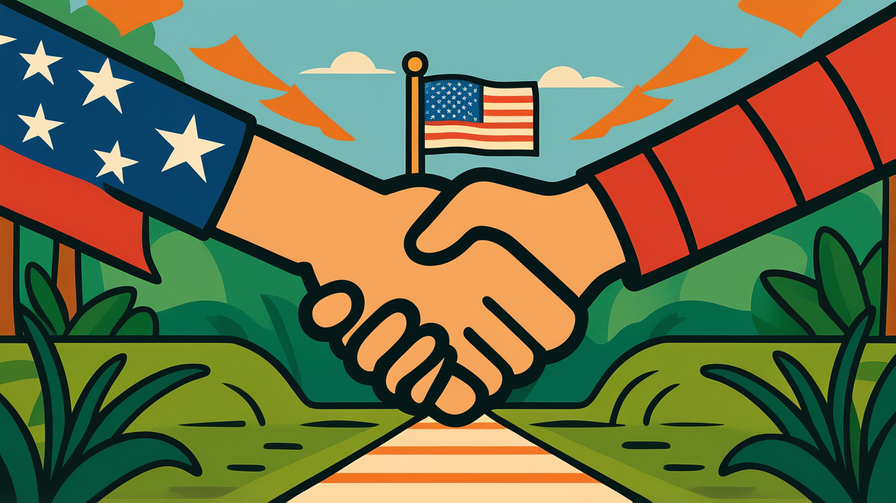[Disclaimer] This article is reconstructed based on information from external sources. Please verify the original source before referring to this content.
News Summary
The following content was published online. A translated summary is presented below. See the source for details.
The United States and Indonesia have announced a joint framework for developing a reciprocal trade agreement, marking a significant milestone in bilateral economic relations. Released on July 22, 2025, this framework establishes the foundation for negotiations on a comprehensive trade deal between the world’s third and fourth most populous nations. The agreement would cover various sectors including manufacturing, agriculture, digital trade, and services. Both nations aim to reduce trade barriers, increase market access, and strengthen supply chains in the Indo-Pacific region. This development comes as both countries seek to diversify their trading partnerships and reduce dependence on other major economies. The framework emphasizes sustainable development, labor rights, and environmental protections alongside traditional trade considerations.
Source: White House News
Our Commentary
Background and Context

Indonesia is Southeast Asia’s largest economy and the world’s fourth most populous country with over 270 million people. It’s an archipelago of over 17,000 islands stretching from the Indian to the Pacific Ocean. Think of it as a massive country made up of thousands of islands, each with unique resources and cultures.
Trade agreements are like rulebooks for how countries do business with each other – they determine what products can be sold, what taxes (tariffs) apply, and what standards must be met. Currently, the US and Indonesia trade about $35 billion worth of goods annually, but both countries believe this could grow significantly.
The term “reciprocal” means both countries agree to treat each other fairly and equally – if Indonesia reduces barriers for American products, the US does the same for Indonesian goods.
Expert Analysis
This framework is strategically important for several reasons. The Indo-Pacific region is becoming the world’s economic center of gravity, with over half of global GDP expected to come from this area by 2040. Both the US and Indonesia want to strengthen their positions in this dynamic region.
For the US, this agreement offers an alternative to Chinese economic influence in Southeast Asia. It’s part of a broader strategy to build economic partnerships with democratic nations in the region. For Indonesia, it provides access to American technology, investment, and markets while reducing dependence on any single trading partner.
The emphasis on sustainable development and labor rights reflects modern trade agreement priorities – it’s not just about moving goods cheaply, but doing so responsibly.
Additional Data and Fact Reinforcement
Indonesia is rich in natural resources including palm oil, coal, copper, and nickel – the latter being crucial for electric vehicle batteries. The US is a major exporter of technology, aircraft, soybeans, and cotton. This complementary relationship means both countries have much to gain.
Current trade statistics show the US exports about $9 billion to Indonesia annually while importing about $26 billion, creating a trade deficit the US likely wants to address. Major Indonesian exports include textiles, footwear, electronics, and palm oil, while the US sends aircraft, machinery, cotton, and soybeans.
Young Indonesians are increasingly connected to global markets – over 200 million Indonesians use the internet, creating opportunities for digital trade in services, entertainment, and education.
Related News
This framework fits into broader US Indo-Pacific economic initiatives, including the Indo-Pacific Economic Framework (IPEF) launched in 2022. Indonesia is also negotiating trade deals with the European Union and expanding its role in ASEAN (Association of Southeast Asian Nations) economic integration.
Both countries are investing heavily in green technology and renewable energy, areas likely to feature prominently in the trade agreement. Indonesia’s nickel reserves are particularly important for the global transition to electric vehicles.
Summary

The US-Indonesia trade framework represents a significant step toward deeper economic integration between two major democracies in an increasingly important region. For young people in both countries, this could mean new job opportunities, access to different products and services, and increased cultural exchange. While frameworks are just the beginning – actual agreements can take years to negotiate – this announcement signals both nations’ commitment to strengthening their economic partnership in ways that benefit workers, businesses, and consumers while respecting environmental and social standards.
Public Reaction
Business communities in both countries have welcomed the announcement, particularly tech companies seeking easier data flows and manufacturers wanting simplified supply chains. Environmental groups are watching closely to ensure palm oil and mining provisions include strong sustainability requirements. Students and young professionals see opportunities for increased educational and work exchanges between the two nations.
Frequently Asked Questions
How will this affect prices of everyday goods? Trade agreements typically reduce prices by eliminating tariffs, but effects vary by product. Americans might see cheaper textiles and electronics, while Indonesians could access more affordable American technology and agricultural products.
What does this mean for jobs? Trade can create new jobs in competitive industries while challenging others. Both governments emphasize protecting workers’ rights and providing training for new opportunities in growing sectors.
When will the agreement take effect? Frameworks typically lead to years of negotiations. If successful, the actual agreement might be signed in 2-3 years, with implementation taking another year or more.


